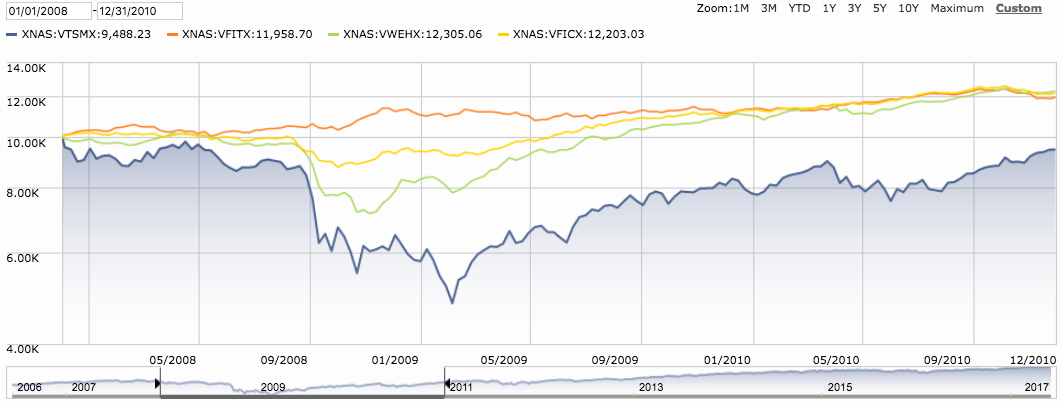Safe to go the Bonds route 5 years from retirement?
Let's look at the bear market historical data from the Hardfordfunds.com
________________________________________________
Bear Markets Have Been Common S&P 500 Index declines of 20% or more, 1929–2020
Start and End Date % Price Decline Length in Days
9/7/1929–11/13/1929 -44.67 67
4/10/1930–12/16/1930 -44.29 250
2/24/1931–6/2/1931 -32.86 98
6/27/1931–10/5/1931 -43.10 100
11/9/1931–6/1/1932 -61.81 205
9/7/1932–2/27/1933 -40.60 173
7/18/1933–10/21/1933 -29.75 95
2/6/1934–3/14/1935 -31.81 401
3/6/1937–3/31/1938 -54.50 390
11/9/1938–4/8/1939 -26.18 150
10/25/1939–6/10/1940 -31.95 229
11/9/1940–4/28/1942 -34.47 535
5/29/1946–5/17/1947 -28.78 353
6/15/1948–6/13/1949 -20.57 363
8/2/1956–10/22/1957 -21.63 446
12/12/1961–6/26/1962 -27.97 196
2/9/1966–10/7/1966 -22.18 240
11/29/1968–5/26/1970 -36.06 543
1/11/1973–10/3/1974 -48.20 630
11/28/1980–8/12/1982 -27.11 622
8/25/1987–12/4/1987 -33.51 101
3/24/2000–9/21/2001 -36.77 546
1/4/2002–10/9/2002 -33.75 278
10/9/2007–11/20/2008 -51.93 408
1/6/2009–3/9/2009 -27.62 62
2/19/2020–3/23/2020 -33.92 33
Average -35.62 289
Past performance does not guarantee future results. Investors cannot directly invest in an index. As of 8/31/20. Source: Ned Davis Research, 9/20.
________________________________________________
5 years is 1825 days and since the longest bear market is 630 days, 5 years is safe and conservative in my opinion because if the crash happens when you are 100% stock, there is a good chance of recovery before you retire based on the above data However, be aware of the "Past performance does not guarantee future results" statement which means there is no guarantee in investing.
The other subject is how much bonds?
Let assume a portfolio of $1.5M and your annual expense is $50K per year. Let's also assume that you want a 3 year hedge. This is a bond of $150K which is a 90%/10% portfolio. Some FA suggest a 60%/40% portfolio which is conservative since this is $600K or a 12 year hedge.
Let's estimate the cost of under performance: Typical average S&P500 return is about 10% and corporate bonds is about 7%. This is an under performance of 3%.
3% x $150K = $4,500 per year of under performance for a 90/10
3% x $600K = $18,000 per year of under performance for a 60/40
There is no right answer. It all depends on your risk tolerance. Some investors are very conservative while other are very aggressive. Investors should balance the safety of bonds with the under performance cost of bonds compared to equities. Afterwards, you should consult other investors and FA to verify your decision is a sound one. My advice is to learn all you can before you reallocate.

